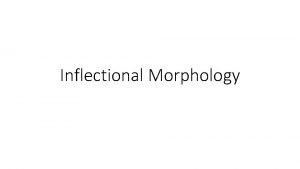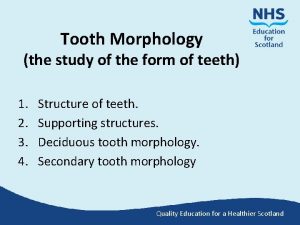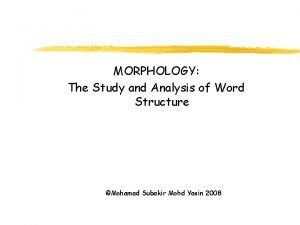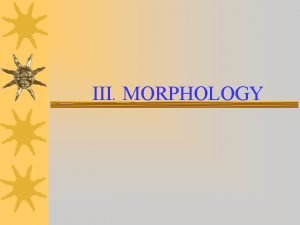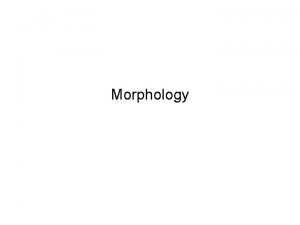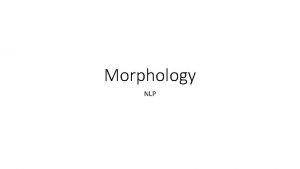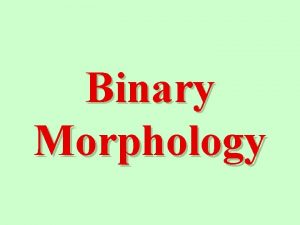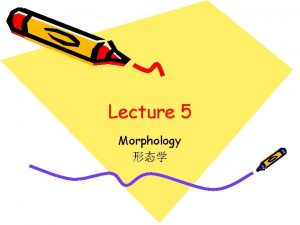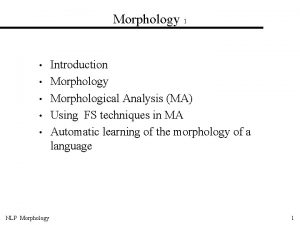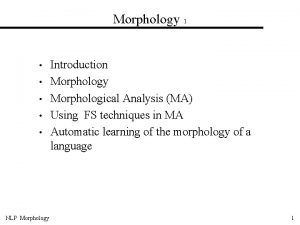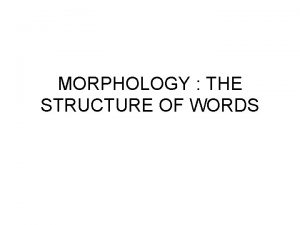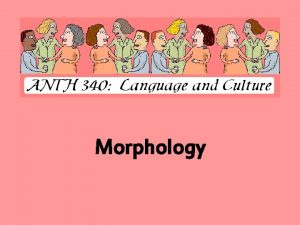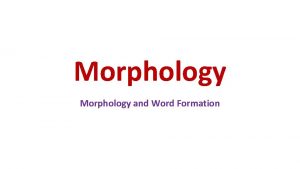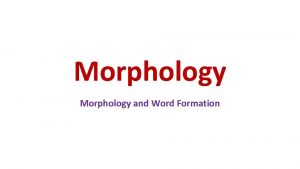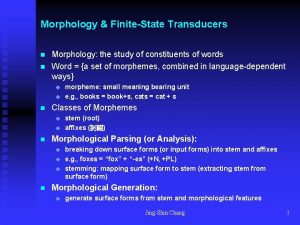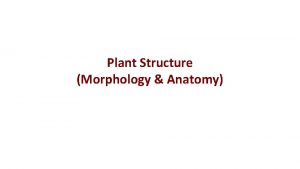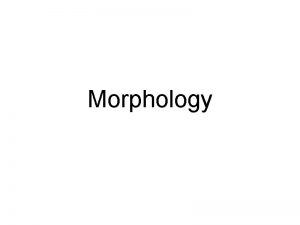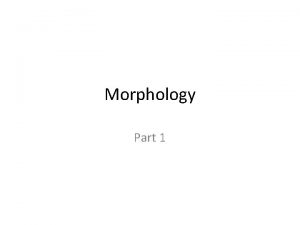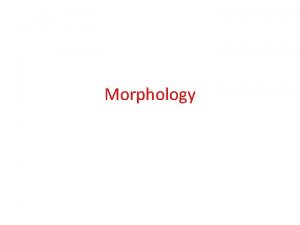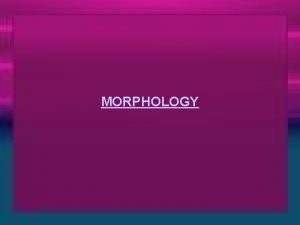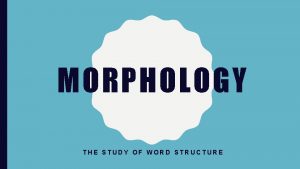MORPHOLOGY Definition of Morphology Literally the study of



















![Morphs and Allomorphs [a book an egg] 1. cats bags 2. liked grabbed wanted Morphs and Allomorphs [a book an egg] 1. cats bags 2. liked grabbed wanted](https://slidetodoc.com/presentation_image_h2/2b1fee6e729e1213680564b5fc3a2dc7/image-20.jpg)




- Slides: 24

MORPHOLOGY

Definition of Morphology • Literally, “the study of forms” • “The branch of linguistics that is concerned with the relation between meaning and form, within words and between words”. • Morphological processes fulfill two basic purposes: (1) to create new words in a language and (2) to modify existing words.

Morpheme • “A minimal unit of meaning or grammatical function”. • Units of grammatical function include forms used to indicate past tense or plural. • For example: The police reopened the investigation. • The word reopened consists of three morphemes. One minimal unit of meaning is open, another minimal unit of meaning is re(meaning ‘again’) and a minimal unit of grammatical function is -ed (indicating past tense).

tourists tour -ist -s unsystematically unsystem -atic -al -ly

Exercise 1 How many morphemes are there in the following sentences? a. In our society we are often paid according to the number of hours or days worked. b. Technology is becoming important in both our personal and professional lives.

Two Types of Morphemes: Free and Bound There are two types of morphemes. • Free morphemes are morphemes that can stand by themselves as single words, for example, open and tour. • Bound morphemes are morphemes that cannot normally stand alone and are typically attached to the free morpheme, exemplified as re-, -ist, -ed, -s. • Bound morphemes are well-known as affixes. • Affixes consists of prefixes and suffixes.

reopened re- = open = -ed = bound morpheme free morpheme bound morpheme tourists tour = -ist = -s = free morpheme bound morpheme

unsystematically unsystem -atic -al -ly = = = bound morpheme free morpheme bound morpheme

Exercise 2 Identify the bound and free morphemes that the sentence below has. a. The only way to develop a good command of the English language is to master the rules and apply them accordingly in your speech and writing. b. This superficial difference in form disguises the fact that the two sentences are very closely related, even identical, at some less superficial level.

Simple & Complex words • Words that consist of just a single morpheme (usually a free morpheme) are called simple words. • Words that consist of more than one morpheme are called as complex words. Happy = simple word Unhappy = complex word Establish =… Establishment = … Antidisestablishmentarianism =…

Two Types of Free Morphemes: Lexical and Functional • Lexical morphemes are morphemes that carry the 'content' of the messages we convey (nouns, verbs, adjectives, adverbs) For example: girl, man, house, tiger, sad, long, yellow, sincere, open, look, follow, break. • Functional morphemes are morphemes that carry the grammatical meaning (conjunctions, prepositions, articles, pronouns, etc. ) For example: and, but, when, because, on, near, above, in, the, that, it, them.

Exercise 3 Classify the free morphemes in the following sentence into lexical and functional morphemes. Travel is part of the lives of many young people of university age, and of the majority of those living in developed and wealthy countries.

Two Types of Bound Morphemes: Derivational and Inflectional • Derivational morphemes are morphemes used to make new words, possibly but not necessarily resulting in a change in a syntactic category. For example, the addition of the derivational morpheme -ness changes the adjective good to the noun goodness. • Inflectional morphemes are morphemes used to indicate grammatical functions (they never change the syntactic category)

teach (v) teacher (n) -er = derivational morpheme happy (adj) unhappy (adj) un- = derivational morpheme

book (n) books (n) -s = inflectional morpheme open (v) opened (v) -ed = inflectional morpheme

friend (n) friends (n) -s= inflectional morpheme friend (n) friendship (n) -ship = derivational morpheme

Exercise 4 Identify the words from the sentence below that are formed by adding the derivational and inflectional morphemes. Despite its worldwide use, English is still considered the most difficult European languages to learn, primarily because its unique characteristics hinder non-native English speakers from obtaining a strong command of it.

Morphological Description

Exercise 5 Provide the morphological description for the words of the following sentence. The spread of English around the world has been and continues to be both rapid and unpredictable.
![Morphs and Allomorphs a book an egg 1 cats bags 2 liked grabbed wanted Morphs and Allomorphs [a book an egg] 1. cats bags 2. liked grabbed wanted](https://slidetodoc.com/presentation_image_h2/2b1fee6e729e1213680564b5fc3a2dc7/image-20.jpg)
Morphs and Allomorphs [a book an egg] 1. cats bags 2. liked grabbed wanted churches

• Morphs refer 'the actual forms or phonological realizations of morphemes. ' • Allomorphs refer to 'the morphs that function as (phonetic) variants of a morpheme. '



References Yule, George. (2006). The study of language. New York: Cambridge University Press.
 Derivational vs inflectional morphemes
Derivational vs inflectional morphemes Tooth morphology definition
Tooth morphology definition Analysis of word structure
Analysis of word structure Hình ảnh bộ gõ cơ thể búng tay
Hình ảnh bộ gõ cơ thể búng tay Frameset trong html5
Frameset trong html5 Bổ thể
Bổ thể Tỉ lệ cơ thể trẻ em
Tỉ lệ cơ thể trẻ em Voi kéo gỗ như thế nào
Voi kéo gỗ như thế nào Tư thế worm breton
Tư thế worm breton Bài hát chúa yêu trần thế alleluia
Bài hát chúa yêu trần thế alleluia Môn thể thao bắt đầu bằng từ đua
Môn thể thao bắt đầu bằng từ đua Thế nào là hệ số cao nhất
Thế nào là hệ số cao nhất Các châu lục và đại dương trên thế giới
Các châu lục và đại dương trên thế giới Công thức tiính động năng
Công thức tiính động năng Trời xanh đây là của chúng ta thể thơ
Trời xanh đây là của chúng ta thể thơ Cách giải mật thư tọa độ
Cách giải mật thư tọa độ 101012 bằng
101012 bằng độ dài liên kết
độ dài liên kết Các châu lục và đại dương trên thế giới
Các châu lục và đại dương trên thế giới Thơ thất ngôn tứ tuyệt đường luật
Thơ thất ngôn tứ tuyệt đường luật Quá trình desamine hóa có thể tạo ra
Quá trình desamine hóa có thể tạo ra Một số thể thơ truyền thống
Một số thể thơ truyền thống Cái miệng nó xinh thế chỉ nói điều hay thôi
Cái miệng nó xinh thế chỉ nói điều hay thôi Vẽ hình chiếu vuông góc của vật thể sau
Vẽ hình chiếu vuông góc của vật thể sau Biện pháp chống mỏi cơ
Biện pháp chống mỏi cơ
